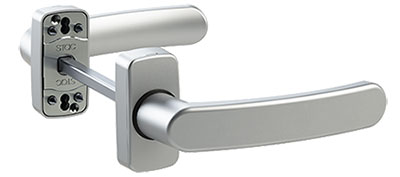We are all conscious that public use of pedestrian doors are subject to all types of forces, blows and suffer too much effort than should be used to open the door in the case of doors with door closers and are fitted to all types of profiles that have very different wall thicknesses. In the case of replacements we find many times that the self tapping holes of the previous handle prevent a correct fixing of the new handle.
 |
More and more, security becomes increasingly important from the point of view of burglary and the installers value the simplicity of assembly, the possibility of having whatever colour and handles that do not have a right or left hand (ambidextrous).
All of these points have been taken in to account by the STAC Product Design and Development Department when creating the new Polaris door handle.
The design premises of this new handle have been:
1.- To be the most hard wearing door handle on the market.
Based on this, all the mechanisms have been designed and manufactured in Zamak and eliminating the plastic parts that had any type of resistance.
The internal mechanism has been encased within the body of the handle with a lower reinforcement cover so that all the forces are spread uniformly over the mechanism. The wear of the moving pieces is minimum resulting in maximum durability of the product.
Axial resistance:
Our product has been tested internally following the specifications of the UNE-EN-1906/2010 standard and for the most restrictive category with respect to use being grade 4 and have achieved the following completely satisfactory results which are very much above the actual requirement:
Standard requirement for grade 3/4 axial resistance and a loading of 100 kgs. with a permanent deformation of ≤2mm
The test result on the first samples with a loading of 100 kgs. permanent deformation was 0.5mm<<<<<2mm, in other words 75% less than the standard requirements.
Note: In order to put in to a value the resistance properties of our product, it is only necessary to indicate that the said standard shows the maximum demand for axial resistance applicable only for security devices and that it corresponds with the category grade 3/4 which indicates that the handle must support an application of a 250 kgs. loading without breaking.
In our case the samples tested obtained resistance results of above 428 kgs. without breaking. We do not know the final value as it reached the limits of the test bench.
Resistance to use (durability cycles)
Following the specifications of the UNE-EN 1906/2010 standard, the most restrictive demand corresponds to the category grade 3/4 being 200,000 cycles with a force of 10 kgs.
We have internally tested the samples and have obtained resistance results very much above the minimum requirement and actually stopped the test at 800,000 cycles with no component breakages.
2. – To be a handle of perceived good quality and have a robust feel.
To achieve this we have reduced the working pieces to a bare minimum and have added an adjustment washer made from high resistance Acetyl Resin with self lubricanting additives and have changed the transversal screw for the handle fixing to the transmssion for a through screw to the shaft. With this change it secures the assembly and product control and eliminates a risk factor regarding an incorrect handle assembly resulting in non desired sets appearing.
3.- Simplicity of assembly – Directly on to the profile.
The handle base has been designed as two pieces in order to be able to turn the top cover and screw directly. For the installer this means a reduction in assembly time.
The handle is supplied completely assembled and ready for installation which eliminates the uncertainty of a defective assembly.
The handles are neither left or right handed but ambidextrous. This means less stock and eliminates errors when fitting on to the profile.
4.-Triple fixing possibilities
This is one of the strongest and more important points of this product as the door handles have to withstand time when fixed to the profile. For that reason we have designed the product so that it adapts to three different fixing systems:
This system is compatible with either of the other two tand the majority of the locks on the market that allow a 21.5 and/or 25 mm fixing passage.
It is also possible to find hybrid fixing systems as a combination of those mentioned.
5.- The possibility of painting in any of the RAL chart colours or Anodised
We have taken in to consideration during the design of the part the possibility of having the product painted with any of the colours from the RAL chart and as from July 2015 the anodised version of the product will be made available.
The product has been conceived so that any client can buy it in with no surface finish, to be painted and easily assemble it using some simple assembly instructions.
7.- Completing the POLARIS / SIRIUS range
This product complements the Polaris and Sirius handle range with a handle having features that up to now are unknown in the market.

